While motorcycling in urban environments has grown in popularity in recent years, the foundation of the hobby is still where it’s always been: adventure. And when you’re exploring far away areas that you don’t know very well, there’s nothing better for navigation than a dedicated motorcycle-specific GPS navigation system that you can display near your controls.
More accurate, easier to use, and significantly more weatherproof than a smartphone, a GPS is great for those who don’t want to expose their smartphone to the elements. A motorcycle GPS is also easier to mount and has more motorcycle-specific features than a car GPS. There’s a reason motorcycle GPS systems have had continued success even as the adoption of car GPS systems has fallen dramatically over the last decade.
- Features to Consider in a Motorcycle GPS Navigation System
- Top 10 Best Motorcycle GPS Navigation Systems 2025
- 1. Best Overall Motorcycle GPS System: Garmin Zumo 395 LM
- 2. Best Premium Motorcycle GPS: Garmin Zumo 595 LM
- 3. Best Budget Motorcycle GPS: Koolertron 4.3-Inch Motorcycle GPS
- 4. Garmin Zumo 396 LMT-S
- 5. Best for Offroad Riding: Trail Tech Voyager Pro UTV GPS 4-Inch Touch Screen
- 6. Garmin Zumo XT 5.5-Inch Ultrabright
- 7. TomTom GO Supreme
- 8. Magellan TRX7 CS GPS Navigator
- 9. Best for Luxury Touring Bikes: BMW Navigator VI by Garmin
- 10. TomTom GO Supreme
- Guide to Buying the Best Motorcycle GPS Navigation Systems for 2025
- Wrapping Up
Expensive and vitally important for long, remote, or backcountry trips, a GPS navigation system is well worth researching and understanding. While some units are a bit better for urban and fair-weather duty, other units are designed to keep going well off the beaten track. Make sure you’re purchasing a unit that is capable of going as long and as hard as you can.
Screen Size
While motorcycle GPS navigation systems are on average quite a bit smaller than truck and car units, some motorcyclists still prefer a large-ish screen to maximize how much of the map they can see while riding along. A five-inch display is about average, and we wouldn’t go much smaller than four inches.
Also consider color and resolution, as there are many black and white options that get tricky to read. Cheaper devices don’t typically provide HD displays.
Battery Life
With only the newest model years of motorcycles containing mini-USB ports for charging auxiliary devices, you’ll probably want a model with great battery life so you can head out on longer rides. Your priorities and preferences will determine whether you need 3 hours or 8, but make sure you pick a product tailored to your preferences.
GPS Mounts
A solid GPS mount makes the difference between a great day on the bike and a horrible one. Pick your mounting mechanism, your adjustability level, material, and durability. An included GPS mount is a nice touch, but sometimes a cheap mount that will break easily or drop your GPS is worse than no mount at all.
Live Traffic
And you thought a traffic jam in a car was bad! With poor visibility, no air conditioning or heating, the sun beating down, and gas fumes all around, motorcyclists avoid traffic at all costs. For some, it’s worth investing in a product that can keep them updated on the traffic conditions so as to best avoid jams, although if you’re frequently in the backcountry, it might not be worth the price.
Durability
Prone to fall damage, all kinds of weather, and extreme temperatures, motorcycle GPS systems have to be quite a bit more durable and waterproof than their truck and car counterparts. While most units advertise being durable, there are a few specific things to look out for, notably drop tests (look for the Military 810 drop test as a gold standard), Gorilla Glass screens, and waterproofing (IP65, IP66, IPX6, and IPX7 are all considered waterproof, with IP67 and IPX5 being the highest bar). Make sure the manufacturer’s claims are backed up with rigorous testing and certifications.
Motorcycle-Specific Features
You’re buying a motorcycle GPS navigation system, not a car GPS, so make sure you’re getting something that has motorcycle-specific features. There are a couple of nifty features that motorcycle-specific units include that typical consumer units don’t have:
- Headset Compatibility: It’s almost impossible to hear GPS turn-by-turn directions between heavy traffic and strong winds. Look for a device with Bluetooth capability that can connect with the speaker/headset in your helmet.
- Rider Alerts: Speed cameras, railroad crossings, and weather alerts are all things motorcyclists have to pay attention to. Make sure you’re up to date with an advanced GPS that provides you with all the relevant information.
- Motorcycle Routing: Devices frequently are programmed with motorcycle-specific routing options (in Garmin’s case, called ‘Adventurous Routing’) with less traffic, windier roads, and more elevation gain to keep things varied and interesting for enthusiasts.
Keeping these features in mind, make sure you’ve got a good idea of exactly what kind of product you’re looking for. Check out our picks for the best GPS navigation systems on the market below.
| Product | Screen Size | Battery Life | Mount Included | Live Traffic | Rating |
|---|---|---|---|---|---|
| Garmin Zumo 395 LM | 4.3 inches | 7 hours | Yes | Yes | 5 |
| Garmin Zumo 595 LM | 5 inches | 7 hours | Yes | Yes | 5 |
| Koolertron 4.3-Inch Motorcycle GPS | 4.3 inches | 6 hours | Yes | Yes | 4.5 |
| Garmin Zumo 396 LMT-S | 4.3 inches | 6 hours | Yes | Yes | 4.5 |
| Trail Tech Voyager Pro UTV GPS 4-Inch Touch Screen | 7 inches | Must be connected | Yes | Yes | 4.5 |
| Garmin Zumo XT 5.5-Inch Ultrabright | 5.5 inches | Yes | 4 | ||
| TomTom GO Supreme | 4.3 inches | 8 hours | Yes | Yes | 4 |
| Magellan TRX7 CS GPS Navigator | 7 inches | 6 hours | Yes | No | 4 |
| BMW Navigator VI by Garmin | 5 inches | 4 Hours | Yes | Yes | 4 |
| TomTom GO Supreme | 5.5 inches | 5 hours | Yes | Yes | 3.5 |
1. Best Overall Motorcycle GPS System: Garmin Zumo 395 LM
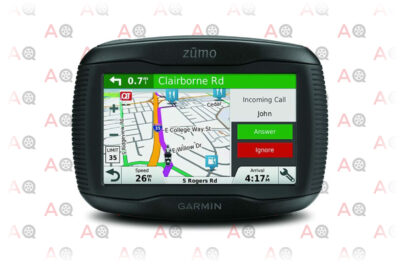
Editor’s Rating:
At a Glance
- Screen Size: 4.3 inches
- Battery Life: 7 hours
- Mount Included: Yes
- Live Traffic: Yes
Review
A 4-inch model with a durable construction fit for off-road riding, the Zumo 395 LM from Garmin takes what motorcyclists need and packages it up in a convenient and effective package. It’s set up to function with a built-in helmet speaker and microphone combo, with hands-free calling and audio turn-by-turn navigation wireless piped to your helmet speaker. You can also use it to set up music, radio, or podcasts with a compatible Bluetooth device.
Pairing the system to your phone is easy, quick, and has good range, meaning you can leave your phone in your pannier and still maintain a connection. The entire system runs on 5-volt power, meaning it’s not particularly demanding on standard 12-volt electrical systems. It includes a suction cup mount that’s really better suited for car use, a handlebar mount that’s practically infallible, and free lifetime map updates.
The only issue we see is that it looks like it came straight out of the nineties with rounded, bladed edges. But the form comes with a function: the device is drop-proof, shatter-proof, and has a bright, high-def screen that can be seen even in bright sunlight and used by gloved riders.
Motorcycle-Specific Features
This isn’t just a motorcycle-specific skin on what’s really a car GPS, it’s designed from top to bottom to solve the issues motorcyclists face on long trips. This starts with motorcycle-specific data, updating the motorcyclist with sharp curve warnings, speed-camera locations, and even displaying local regulations (helmet laws, for example) that flash across the screen when riding into a new jurisdiction.
Like its larger counterpart, the Garmin Zumo 595 LM, the unit also has a feature called ‘Adventurous Routing,’ which routes motorcyclists away from highways and onto scenic, rolling, and curving roads.
Pros
- Perfect for the typical motorcyclist
- Can be set up with Bluetooth for audio output
- Adventurous Routing features lesser-traveled routes
- Motorcycle-specific data like sharp curve warnings and speed-camera locations
Cons
- Relatively small screen
- Suction-cup mount is better for cars than motorcycles

Editor’s Rating:
At a Glance
- Screen Size: 5 inches
- Battery Life: 7 hours
- Mount Included: Yes
- Live Traffic: Yes
Review
The Cadillac (or should we say Ducati?) of motorcycle GPS navigation systems is, without a doubt, this $500-plus unit from industry titan Garmin. Including all of the features we can think of all in a slickly designed, durable, and technologically impressive package, the unit truly has no equal, either in capability or in price.
In fact, price is really one of the only complaints we have about this unit. If you end up having to decide between a small, barn-find project bike and this GPS, the motorcycle itself might cost you less money. But this motorcycle GPS is not for saving money: it’s for the discerning consumer, the motorcyclist who wants Garmin’s premium features (motorcycle-specific routing, an HD full-color display, Bluetooth capability) and who is willing to pay the price. To owners of larger displacement tourers, technophiles (it measures wind speed, for God’s sake!), or lovers of the finer things in life: buy this GPS.
The display is larger than its smaller, less expensive brother, the Garmin Zumo 395 LM and has an IPX7 waterproof designation. Unfortunately, battery life is well below average. Garmin’s logic, if we had to guess, is that users who can afford a $500-plus GPS can probably afford a bike with an auxiliary USB charging port.
Motorcycle-Specific Features
This model, as well as the Garmin Zumo 395 LM has an ‘Adventurous Routing’ mode which sets turn-by-turn directions to look for the most interesting, twistiest, and hilliest roads for those motorcyclists that love interesting, scenic byways.
Pros
- Large format unit has a luxury feel and features
- Full-size 5-inch screen
- ‘Adventurous Routing’ mode routes takes users off the beaten path
- IPX7 waterproof designation
Cons
- Battery life is a bit below average
- Requires a 12-volt charging port
3. Best Budget Motorcycle GPS: Koolertron 4.3-Inch Motorcycle GPS
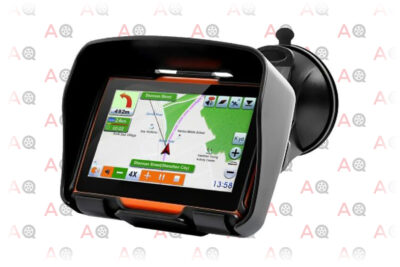
Editor’s Rating:
At a Glance
- Screen Size: 4.3 inches
- Battery Life: 6 hours
- Mount Included: Yes
- Live Traffic: No
Review
A fraction of the price of premium mounts, this GPS system measures a bit over four inches, making it one of the smallest and lightest units to make our lineup. While its touchscreen isn’t quite as responsive as Garmin’s Zumo 395’s hyper-responsive interface, it’s more than effective, even with gloves and even in the rain (it has the same IPX7 rating as Garmin’s products).
It’s really most at home on the handlebars of a dirt bike or an adventure bike, with a mudguard that also serves as a shade for the not-that-bright screen, a drop-proof construction, and several options for mounts, including an ultra-sturdy handlebar mount. Maps are stored on 20GB of memory, four gigs built-in, and another 16GB with an SD card, meaning there’s plenty of space for custom maps of trail networks in your area.
While there’s no speaker for turn-by-turn directions, the unit feeds audible instructions via GPS to any Bluetooth speaker. Simple instructions can be carried out via voice commands, perfect if you’re a fan of using a headset while riding.
Motorcycle-Specific Features
Aside from an ample memory bank for trail riders and the included sturdy handlebar mount, this inexpensive unit doesn’t really have too much distinguishing it from car GPS units other than a burly construction. At the same time, for a device that costs well under $200, you simply can’t expect the same clever (and expensive) motorcycle-specific features as you’d get from a $500 unit.
Pros
- Burly construction and handlebar mount are great for off-road use
- IPX7 waterproof rated
- Mudguard and sunshade incorporated into the design
- 20 GB of memory capacity for custom trail maps
Cons
- Software and features aren’t very different from car GPS systems
- Screen isn’t particularly bright
4. Garmin Zumo 396 LMT-S

Editor’s Rating:
At a Glance
- Screen Size: 4.3 inches
- Battery Life: 6 hours
- Mount Included: Yes
- Live Traffic: Yes
Review
There’s a reason Garmin is the king of the GPS market as a whole, and a reason so many motorcycle owners are willing to pay the slight price premium Garmin charges: the company simply addresses the needs of motorcyclists better than any other GPS company. That’s not to say all of their units are perfect, in fact, this unit has several inconvenient flaws: unreliable Bluetooth pairing, for one, and completely lackluster off-road capability and maps. Nonetheless, though, it’s a strong contender and one of the cheapest Garmins available.
While it’s not as sturdy as the larger Garmin Zumo 595 LM, or as fully featured as its premium counterpart, the Garmin Zumo 395 LM, it still includes the basic features we’ve come to know and love with all Garmins: rider alerts for curves, strong winds, and speed cameras, ‘Adventurous Routing’ (the best motorcycle-specific routing system we’ve come across), and audio turn-by-turn directions.
The unit is somewhat rugged (especially compared to smartphones) and rated to be water-resistant, although not certified IPX7 waterproof. Think of it as an entry point to the Garmin world, with all of the standard features but not necessarily all of the bells and whistles.
Motorcycle-Specific Features
While this GPS is a slightly more budget-oriented option compared with other Garmin units, it’s still fully-featured from a motorcycle-specific perspective. Motorcycle specific routing, rider alerts, Bluetooth pairing for cellphone speakers, and more are all native to the device. The low price really has much more to do with processing power and a less-durable construction than features or software.
Pros
- Garmin motorcycle-specific unit available at a low price
- Fully featured with rider alerts and motorcycle-specific routing
- Relatively rugged construction
- Equipped with adventurous routing off-road features
Cons
- Less durable than most motorcycle GPS units
- Doesn’t have great processing power
5. Best for Offroad Riding: Trail Tech Voyager Pro UTV GPS 4-Inch Touch Screen
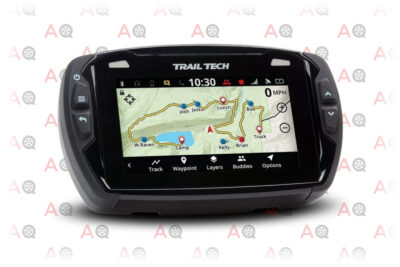
Editor’s Rating:
At a Glance
- Screen Size: 7 inches
- Battery Life: Must be connected
- Mount Included: Yes
- Live Traffic: No
Review
This GPS from powersports company Trail Tech lives up to its name, with phenomenal durability complemented by an IP67 rating for dust proofing and water resistance. It’s drop-resistant as well, although frankly, with an included mount that attaches directly to the handlebar, we’re not worried about it dropping at all.
Although it’s marketed as a UTV GPS system, it’s great for dirt bikers and even adventure motorcyclists, with a few trail networks preloaded. If your local trail network isn’t listed, though, a micro SD card slot is perfect for anyone who needs to load off-road GPX files. Unfortunately, this means there’s next to no road maps loaded on the device, so it’s better suited for trail riders.
There are free road maps available online for various regions of the country, but accurate and up-to-date file packs take a bit of time to track down.
The strangest part of this mount, however, is the fact that it has to be semi-permanently routed and always connected to a battery, although the feature isn’t actually as inconvenient as you might imagine. In fact, if you’ve got the right 12v power ports near your handlebars, it means you’ll end up with a unit that’s affixed more solidly and requires less fuss than battery-powered units like the TomTom Rider 550. The only downside, though, is that if you have an older or more retro-style rig without a 12-volt mini-USB plug, you’re out of luck.
Motorcycle-Specific Features
While there are no live traffic or motorcycle-specific routing features with this GPS system, there are plenty of features that make it great for motorsport. A tracking feature can display the locations of up to 20 riding partners simultaneously, making things safe and social. It’s also got Bluetooth connection capability that enables you to chat with your riding buddies and listen to music through a helmet speaker.
Pros
- Phenomenal for all off-road motorists
- Can be affixed more permanently than GPS systems that require recharging
- Can be loaded with downloaded GPS files
- Free maps available for off-road use
Cons
- Designed for UTVs instead of motorcycles
- No road maps loaded onto the device
- Requires a direct connection to a 12-volt power port
6. Garmin Zumo XT 5.5-Inch Ultrabright
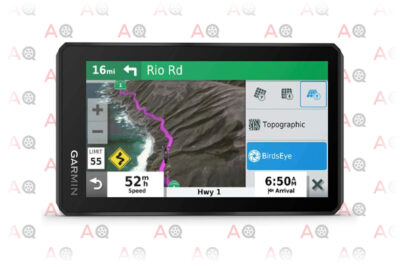
Editor’s Rating:
At a Glance
- Screen Size: 5.5 inches
- Live Traffic: Yes
Review
A slightly more road-oriented relative of the Garmin Zumo 595 LM, the Garmin Zumo XT is a pricey but luxury-feeling GPS perfect for long-distance tourers. While a bigger screen fits a bigger dash, the luxury feel with this device is really meant for a luxury motorcycle.
And while it’s not built with the rugged, rubber protections of an off-road specific GPS system, it still holds up with a rain-resistant screen and a military-rated drop test construction that can withstand repeated drops onto concrete. It’s also waterproof, and the capacitive touchscreen is responsive even with a gloved hand.
For those who like to get out of the city, the GPS overlays satellite images on the map display, enabling riders to figure out where they’re headed and where to go even when the GPX file doesn’t know the route. Like other Garmin devices, it has an ‘Adventurous Routing’ feature that picks out more interesting roads over fast, multilane highways.
Motorcycle-Specific Features
The Garmin Zumo XT delivers on its price tag with a whole host of features designed for motorcyclists that simply aren’t available on other platforms. The device displays live weather and traffic updates, vital for motorcyclists on longer trips in unfamiliar territory. The routes you ride can be recorded for both planning and safety purposes, and waypoints make sure you’re on course and help you rendezvous with your group if you get separated. It can even be synced with your phone to pipe audio to your in-helmet speaker and display notifications on the GPS screen.
Pros
- Road-oriented mount has a healthy-sized 5.5-inch display
- Live traffic and weather updates
- Waypoints and data recording for review
- GPS routes can be overlaid on the map display
- Military rated drop-proof
Cons
- Not as rugged as off-road specific GPS systems
- A bigger screen requires a bigger dash
7. TomTom GO Supreme

Editor’s Rating:
At a Glance
- Screen Size: 4.3 inches
- Battery Life: 8 hours
- Mount Included: Yes
- Live Traffic: Yes
Review
While Garmin has thrived over the last few years, former competitor TomTom has dropped off quite a bit, suffering as smartphones have made inroads against their (pricey) products. The TomTom Rider 550 is a step in the right direction, although it’s admittedly flawed for a few reasons.
Although the company offers a unit that comes with a drop-proof case, we’re frankly a bit confused on why they didn’t just design the GPS to be drop-proof in the first place. At the end of the day, it’s still relatively fall-proof thanks to its vibration-proof stand (included with the purchase), although if you let it fall while removing it from the mount, you could be out of luck. Mapping is flawed as well, as while TomTom advertises an ‘on pavement’ routing feature, it occasionally sends motorcyclists down dirt or gravel roads. Not ideal.
But there’s still plenty to like: an HD screen, live push notifications that come across your screen, and incredibly fast processing all make the unit great from a user-friendliness perspective. We don’t often think about processing when talking about a GPS unit, but the TomTom Rider 550’s quad-core processor means routing, menus, and notifications appear in a flash. No waiting, freezing, or stalling as with less powerful units.
Motorcycle-Specific Features
TomTom does more than just put a motorcycle-specific skin over a car GPS, even creating their own motorcycle-specific route building software for those who like to plan ahead. World maps mean you can take this thing from Norway to Vietnam and stay on track, all the while aided by TomTom’s live traffic feature. Safety alerts auto-populate with no need to be connected to a phone or a mobile network.
Pros
- Powerful processor means quick navigation and no waiting or freezing
- User-friendly design
- Live push notifications automatically populate
- Included vibration-proof mount
Cons
- Unit requires a drop-proof case to match durability of other units
- On-pavement routing feature sometimes doesn’t live up to the name
- Relatively expensive against the competition
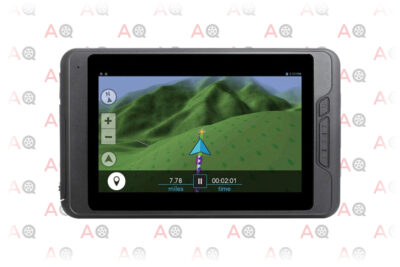
Editor’s Rating:
At a Glance
- Screen Size: 7 inches
- Battery Life: 6 hours
- Mount Included: Yes
- Live Traffic: No
Review
Although GPS manufacturer Magellan was the first company to produce a consumer-ready GPS device, the company has fallen off in recent years due to heavy competition. But the once-distressed group is back on the way up, leveraging their extensive experience and network to produce niche-oriented products, with this specific TRX7 unit knocking it out of the park for its class: large off-road and adventure bikes.
Unlike GPS units that are pretty much off-road specific like the Trail Tech Voyager Pro, this device straddles the line between street and trail fantastically, with 115,000 preprogrammed trails available to display across its 6-inch screen. Also loaded is an entire, up-to-date network of all continental US streets, roads, and highways, meaning that this is one of the most comprehensive GPS units on the market today.
Magellan works hard to correct the errors of their past, offering a product team with extensive customer support and warranty replacement. The user interface, though, and the plasticky-feeling device itself, look like they came straight out of 1990, which is unfortunate for a device that’s almost $500. However, if you can get past the aesthetics, it’s a good alternative to large-format GPS systems like the Garmin Zumo 595 LM.
Motorcycle-Specific Features
The strongest motorcycle-specific features around this device are the maps, on which Magellan offers free lifetime updates. The device also includes worldwide 2D topographical maps of the whole world, as well as 3D topo maps for the entire US and Canada. The device even has a social sharing feature where you can publish your rides online to share with your riding buddies.
Pros
- Large-format GPS comes with over 115,000 preprogrammed trails
- Can be loaded with your own GPX files
- Also includes road and highway maps
- Great customer support and warranty service
Cons
- Aesthetics are dated and plasticky-looking
- The interface looks like something out of 1990

Editor’s Rating:
At a Glance
- Screen Size: 5 inches
- Battery Life: 4 Hours
- Mount Included: Yes
- Live Traffic: Yes
Review
With a five-inch display and a big BMW logo slapped on the front, this GPS system was originally designed for expensive German bikes, but also happens to work great on almost all luxury motorcycles. The device has some great touches, including one of the brightest screens in our lineup. With the system, you’ll get free map updates for life, a quick-connect Bluetooth feature, and accurate turn-by-turn route planning.
While audible directions are broadcasted from the system, you’ll have to connect to a helmet-mounted headset for it to work correctly, as there’s no built-in speaker on the device itself. This is annoying for city riders that might look for that feature directly on the GPS itself.
There are a couple of annoying features, though, that prove that we are indeed dealing with a BMW product. First of all, the product has to be on to charge, something that makes little to no sense. Secondly, the unit actually has two ‘off’ modes, one a true ‘off’ that doesn’t chew up the battery, and the other a ‘sleep’ mode that appears to be off when it really isn’t. Using the wrong ‘off’ mode could mean you go to turn on your GPS and have no battery left.
Motorcycle-Specific Features
While this unit’s ‘Avoid Highways’ feature isn’t as fully-featured or as enjoyable to use as other Garmin products’ ‘Adventurous Routing’ mode, luxury tourers on large-displacement bikes will probably be less likely to intentionally seek out the beaten path and will typically be a bit more comfortable on main roads and highways at higher speeds.
Pros
- Five-inch display shows maps in high definition
- Utilizes a version of motorcycle-specific routing called ‘Avoid Highways’ mode
- Plan trips with turn-by-turn route planning
- Great for luxury tourers and highway riders
- Turn-by-turn directions
Cons
- No built-in speaker system for audio
- Multiple off/sleep settings make it easy to drain the battery
- Product has to be turned on to charge
10. TomTom GO Supreme
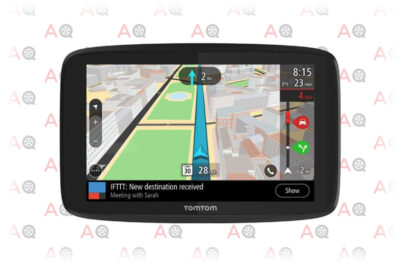
Editor’s Rating:
At a Glance
- Screen Size: 5.5 inches
- Battery Life: 5 hours
- Mount Included: Yes
- Live Traffic: Yes
Review
This inexpensive mount from TomTom is relatively impressive for its price, although as a car specific mount, there are a few aspects that make it annoying for motorcyclists. It’s got an included mount, but it’s magnetic, meaning it’s not particularly secure. You’ll want to buy a handlebar mount if you use this frequently or on rougher roads.
Traffic warnings aren’t motorcycle specific and won’t route you down areas known to be friendly for motorcyclists, but they are convenient if you’re simply trying to avoid a jam. Updates and maps are user friendly as they come in via WiFi (no cable connection or computer required) and load automatically.
Power comes via an accessory outlet, which shouldn’t be a big deal if you have a newer bike with a 12-volt plug, but you’ll have to figure out a work-around if you’re going to mount it on an older bike. Our recommendation? If you’ve got something pre-2010, grab something rechargeable like the Garmin Zumo 395 LM to keep your dash clean and wire-free.
Motorcycle-Specific Features
As a GPS targeted for the car market, there’s obviously nothing that truly stands out as motorcycle-specific. That being said, though, we picked this unit for a few specific reasons to be a representative from the car GPS category. First thing? Speed warnings: it’s easy to get carried away on a liter bike or even a large capacity cruiser, and a speeding ticket will ruin your day. Second thing? Form factor: the TomTom’s shape is ideal for a motorcycle dash and is compatible with a host of GPS handlebar mounts, meaning you’ll have no trouble keeping it attached if you buy a handlebar mount.
Pros
- Live traffic updates will keep you out of annoying jams
- Form factor is great for motorcycle dashes
- Updates and maps come automatically via WiFi
- Speed warnings will keep you out of trouble
Cons
- Construction isn’t motorcycle-specific
- 12-volt power means it only works with accessory outlets
- You’ll need to buy a separate GPS mount
While the GPS industry has been dramatically upset by the advent of GPS capability on smartphones, GPS companies still have great market penetration among motorcyclists, especially touring and adventure riders. The truth is, there’s still no smartphone that works as reliably as a motorcycle GPS.
Safety With a GPS
Using a GPS in a car is difficult and even dangerous in stressful driving conditions, so dealing with a navigation system while driving a motorcycle can be much worse. Operating the screen itself should really be left to the quietest moments while driving, with everything but the slightest adjustments best done while stopped or pulled over. Thankfully, though, motorcycles’ GPS navigation systems are designed with that in mind and are made to be used with minimal hand input and, in some cases, voice control.
Picking a Motorcycle GPS Mount
While plenty of GPS units come with a mount, it’s often inadequate for the rigors of motorcycling. The right mount, though, is worth splurging on, as cheaper options can drop your GPS or have you struggling to keep in the proper position. Don’t skimp! There are a couple of things to look out for:
- Handlebar Mounts: Buy a GPS mount that attaches directly to your handlebar, as the only thing you can be sure of is a direct attachment method that physically screws onto your handlebars. While suction cup mounts are popular based on the fact that they’re universally compatible, they’re simply not as effective as screwed-on mounts.
- Manufacturer-Specific: Manufacturers know their products best, so look for a mount either specific to your motorcycle or, better yet, specific to your GPS unit.
- Certifications and Ratings: Many of the same drop-proof and waterproof ratings are just as valuable in a mount as a GPS itself. Check out IPX7 and other IP ratings for waterproofing and Grade 3B silicone for fatigue resistance.
- Non-Slip/Non-Scratch Material: Silicone and PTFE are two materials to look out for that are fatigue-resistant, won’t scratch your phone, and resist vibration.
Updating Your GPS With Maps
A GPS system is only as good as the maps it uses, and while some companies frequently push out free map updates, others are a bit slower, with discount and private-label companies infrequently (or sometimes never) doling out a fresh update. Units like the TomTom GO Supreme 5 are automatically updated via WiFi.
Most major manufacturers will release a map update on a fixed schedule: if you happen to own a GPS from a well-known company such as TomTom or Garmin, you can simply connect your GPS around three times a year, download the maps from the company website, and upload via a mini-USB port.
If you have a GPS from a more niche manufacturer, you’ll have to do your own research into the frequency of updates. If you frequently ride on changing trail systems or in certain geographical areas, make sure you purchase a GPS that accurately displays those regions.
How to Plan Routing for Motorcycles
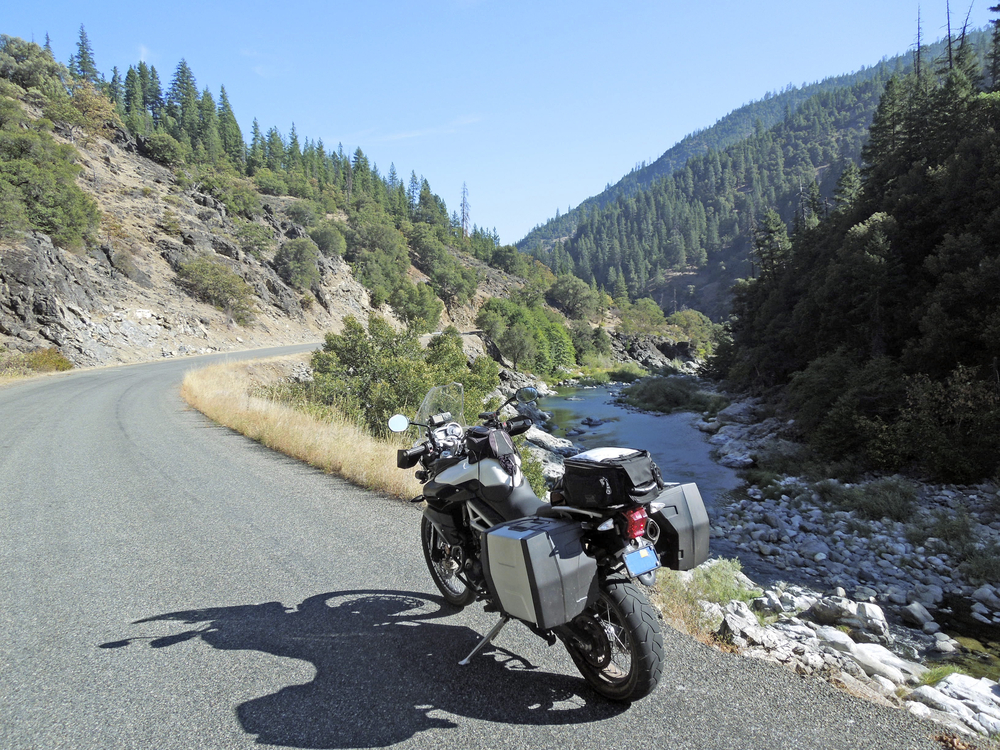
While wide four-lane highways are great for getting from place to place in an enclosed vehicle, most motorcyclists prefer the scenic route, or at least the road less traveled. Some motorcycles, typically under 150cc, aren’t even allowed on freeways, which makes motorcycle-specific routing necessary in many cases. If you’re looking for motorcycle trails and don’t already have a GPS with preloaded trails like the Magellan TRX7 CS Dual Mount Trail and Street GPS Navigator, GPS files for off-roading aren’t too hard to find: check out this article on finding moto trails.
Other Convenient Motorcycle Products
Although many motorcyclists reminisce on the golden days of bikers ripping across the country on loud, carbureted Indians and Harley-Davidsons, there’s a consolation prize for those who settle for more advanced and refined (dare we say delicate) engine tech: we truly live in the golden of motorcycle accessories. Consider some of these products along with your new GPS system:
- Phone Mounts: Plenty of motorcyclists like to have a GPS for navigation and a phone mount in place for more general use. Look for something high grade, drop-proof, and with sturdy grippers to protect your expensive phone.
- Helmet Speakers: Get turn by turn directions from your Bluetooth GPS system via a speaker or helmet headset. Make sure it will fit in your existing helmet.
- Motorcycle Panniers: If you’ve got a motorcycle GPS, you’re probably into motorcycle touring. Don’t settle for inexpensive saddlebags, get some motorcycle-specific panniers or hard seat boxes to keep your gear safe, sound, and dry even in the gnarliest of conditions.
- GPS Mounts: A GPS mount is worth its weight in gold, holding a GPS in place and preventing disastrous drops or annoying vibrations. Look for one that will fit your GPS device’s size and your motorcycle’s dash.
Should I Use a Phone App or Motorcycle GPS System?
There’s been a GPS revolution in the last ten years, with most drivers and plenty of motorcyclists switching to using their phone instead of purchasing a dedicated system. While this approach is fine for some, and typically less expensive (no need to purchase a secondary device), there are some distinct advantages to owning a GPS system.
- Motorcycle-Specific Features: Some GPS map applications are meant for motorcyclists, but they’re typically expensive and less capable than GPS devices. Motorcycle-specific routing and alerts are just a few of the advantages that a GPS system has over a phone app.
- Weatherproofing: Even though some phones claim to be waterproof, they have nowhere near the same drop resistance or weather resistance as a dedicated GPS device. While you have to baby your phone, you’ll never have to baby a military-grade, drop-proof GPS system.
- Cell Service: While most phones have a built-in GPS, they typically rely on cell signal to load the maps themselves. No service means you’re out of luck, and that’s bad news when you’re in the backcountry. A GPS unit only needs a view of the sky to work perfectly.
Wrapping Up
A GPS is one of those motorcycle products that, once you’ve tried it out once, you need all the time. Whether it’s providing security in the backcountry, helping you find the scenic route, or keeping you hands-free and safe on the highway, motorcycle GPS navigation systems have gone head to head with smartphones and come out better than ever. For any frequent motorcyclists, they’re well worth a serious look.


